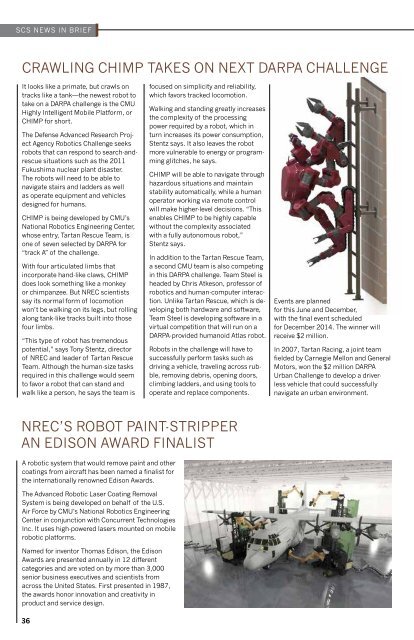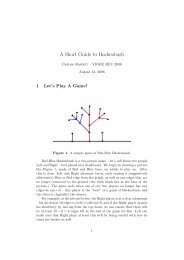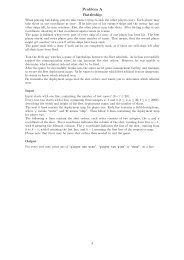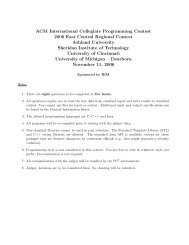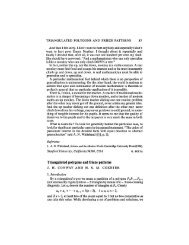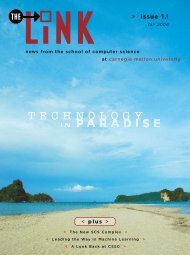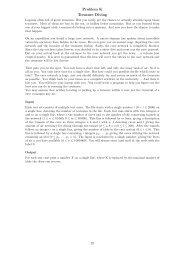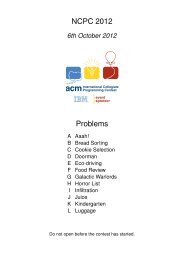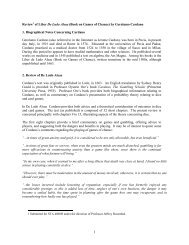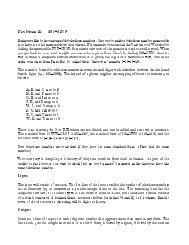Download now (1.3MB, PDF reader required) - Link home page
Download now (1.3MB, PDF reader required) - Link home page
Download now (1.3MB, PDF reader required) - Link home page
Create successful ePaper yourself
Turn your PDF publications into a flip-book with our unique Google optimized e-Paper software.
SCS NEWS IN BRIEF<br />
CRAWLING CHIMP TAKES ON NExT DARPA CHALLENGE<br />
It looks like a primate, but crawls on<br />
tracks like a tank—the newest robot to<br />
take on a DARPA challenge is the CMU<br />
Highly Intelligent Mobile Platform, or<br />
CHIMP for short.<br />
The Defense Advanced Research Project<br />
Agency Robotics Challenge seeks<br />
robots that can respond to search-andrescue<br />
situations such as the 2011<br />
Fukushima nuclear plant disaster.<br />
The robots will need to be able to<br />
navigate stairs and ladders as well<br />
as operate equipment and vehicles<br />
designed for humans.<br />
CHIMP is being developed by CMU’s<br />
National Robotics Engineering Center,<br />
whose entry, Tartan Rescue Team, is<br />
one of seven selected by DARPA for<br />
“track A” of the challenge.<br />
With four articulated limbs that<br />
incorporate hand-like claws, CHIMP<br />
does look something like a monkey<br />
or chimpanzee. But NREC scientists<br />
say its normal form of locomotion<br />
won’t be walking on its legs, but rolling<br />
along tank-like tracks built into those<br />
four limbs.<br />
“This type of robot has tremendous<br />
potential,” says Tony Stentz, director<br />
of NREC and leader of Tartan Rescue<br />
Team. Although the human-size tasks<br />
<strong>required</strong> in this challenge would seem<br />
to favor a robot that can stand and<br />
walk like a person, he says the team is<br />
focused on simplicity and reliability,<br />
which favors tracked locomotion.<br />
Walking and standing greatly increases<br />
the complexity of the processing<br />
power <strong>required</strong> by a robot, which in<br />
turn increases its power consumption,<br />
Stentz says. It also leaves the robot<br />
more vulnerable to energy or programming<br />
glitches, he says.<br />
CHIMP will be able to navigate through<br />
hazardous situations and maintain<br />
stability automatically, while a human<br />
operator working via remote control<br />
will make higher-level decisions. “This<br />
enables CHIMP to be highly capable<br />
without the complexity associated<br />
with a fully autonomous robot,”<br />
Stentz says.<br />
In addition to the Tartan Rescue Team,<br />
a second CMU team is also competing<br />
in this DARPA challenge. Team Steel is<br />
headed by Chris Atkeson, professor of<br />
robotics and human-computer interaction.<br />
Unlike Tartan Rescue, which is developing<br />
both hardware and software,<br />
Team Steel is developing software in a<br />
virtual competition that will run on a<br />
DARPA-provided humanoid Atlas robot.<br />
Robots in the challenge will have to<br />
successfully perform tasks such as<br />
driving a vehicle, traveling across rubble,<br />
removing debris, opening doors,<br />
climbing ladders, and using tools to<br />
operate and replace components.<br />
Events are planned<br />
for this June and December,<br />
with the final event scheduled<br />
for December 2014. The winner will<br />
receive $2 million.<br />
In 2007, Tartan Racing, a joint team<br />
fielded by Carnegie Mellon and General<br />
Motors, won the $2 million DARPA<br />
Urban Challenge to develop a driverless<br />
vehicle that could successfully<br />
navigate an urban environment.<br />
NREC’S ROBOT PAINT-STRIPPER<br />
AN EDISON AWARD FINALIST<br />
A robotic system that would remove paint and other<br />
coatings from aircraft has been named a finalist for<br />
the internationally re<strong>now</strong>ned Edison Awards.<br />
The Advanced Robotic Laser Coating Removal<br />
System is being developed on behalf of the U.S.<br />
Air Force by CMU’s National Robotics Engineering<br />
Center in conjunction with Concurrent Technologies<br />
Inc. It uses high-powered lasers mounted on mobile<br />
robotic platforms.<br />
Named for inventor Thomas Edison, the Edison<br />
Awards are presented annually in 12 different<br />
categories and are voted on by more than 3,000<br />
senior business executives and scientists from<br />
across the United States. First presented in 1987,<br />
the awards honor innovation and creativity in<br />
product and service design.<br />
36


